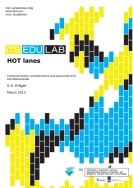The road network in the Netherlands can be considered as saturated with considerable levels of congestion. Not so long ago, mobility policies focused mainly on reducing travel times. But we have recently come to realise that travelling time reliability is at least as important to travellers, hauliers and shippers. The importance of travelling time reliability for passenger and goods traffic has been acknowledged by government and local authorities. A possible answer to the problems presented itself in the U.S. due to circumstances with regard to the poor performance displayed by the previously developed dedicated carpool lanes. By allowing also the solo drivers to use the lanes conditioned by the payment of a toll, the High Occupancy Toll (HOT) lanes were developed. The concept could present itself as a solution for further advancements regarding road pricing in the Netherlands.
By addressing major aspects that include several influencing factors on the operations’ outcome a methodology is developed. Comprised of two major phases, the methodology includes all the necessary elements ranging from initial planning and the corresponding goals and objectives, up to the implementation setup that provide insight on the interaction of design aspects and performance indicators. The first phase provides the steps for screening, ranking and selecting the suitable location and the corresponding conditions for the concept to be feasible. This is achieved with the use of criteria and specific indicators that ensure the fact that the chosen location enhances the potential of the concept. The second phase is more extensive as it includes all the possible design and operations options into the development of scenarios that are evaluated and adapted with the use of a modelling procedure that provides the necessary results.
The methodology is applied to specific cases in order to assess and clarify usability aspects that dictate its efficiency. Several locations are analysed based on criteria such as congestion, reliability, demand and physical attributes and subsequently ranked with the use of determined weights. A specific location is then picked for the application of Phase 2. An adapted modelling framework is devised around a chosen existing traffic simulation model. The inclusion of several user groups is arranged (income classes) and the addition of a mode choice model for the carpooling is made. Another addition is the algorithm developed for the determination and iteration of toll values. Due to unpredicted issues of compatibility, the model evaluation results of the scenarios could not be used to gain insight and subsequently determine a best implementation setup. Although no specific evaluation has been conducted, the methodology is considered to be able to produce a potentially successful implementation setup for a HOT-lane concept.
Further research and attention need to be considered with regards to the modelling framework. Due to the extensive behavioural aspects that can be included, adapting or even developing a traffic simulation model is a challenge. In terms of future consideration of the concept for the Netherlands, HOT-lanes should be put in relation or combination with existing dedicated managed lanes such as the rush-hour or truck only lanes. A pilot study involving a HOT-lane concept can be feasible as it could provide valuable insight also for other traffic management developments.
